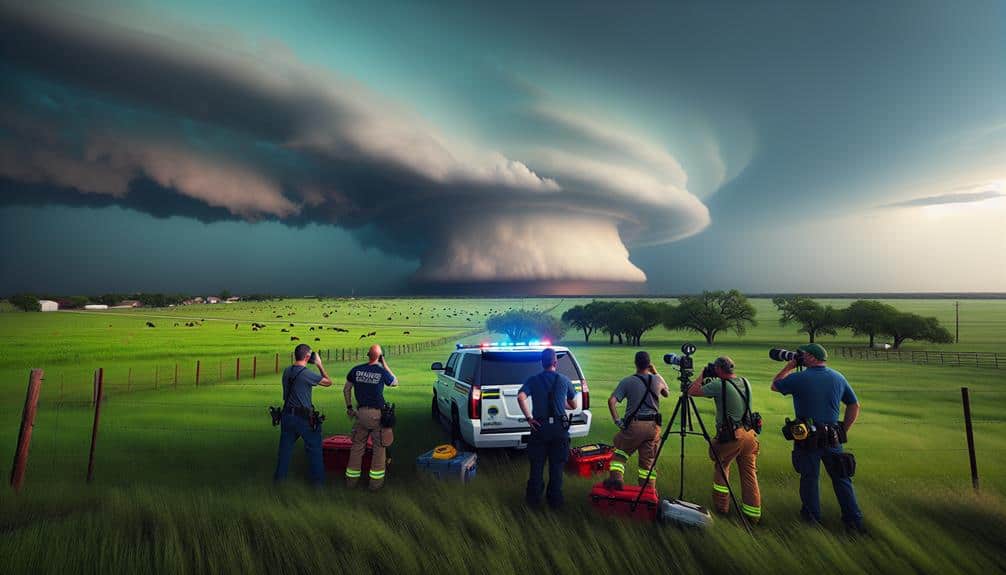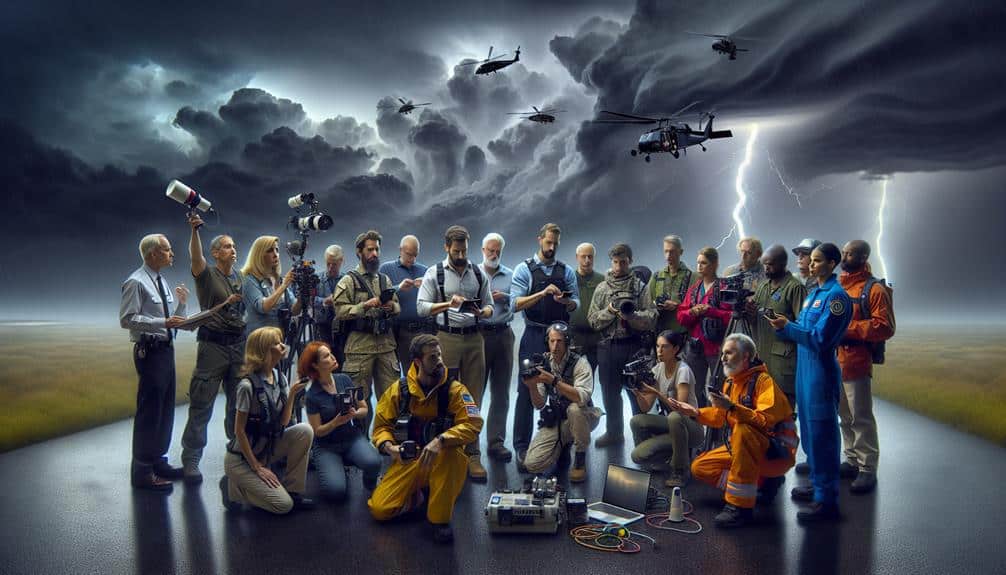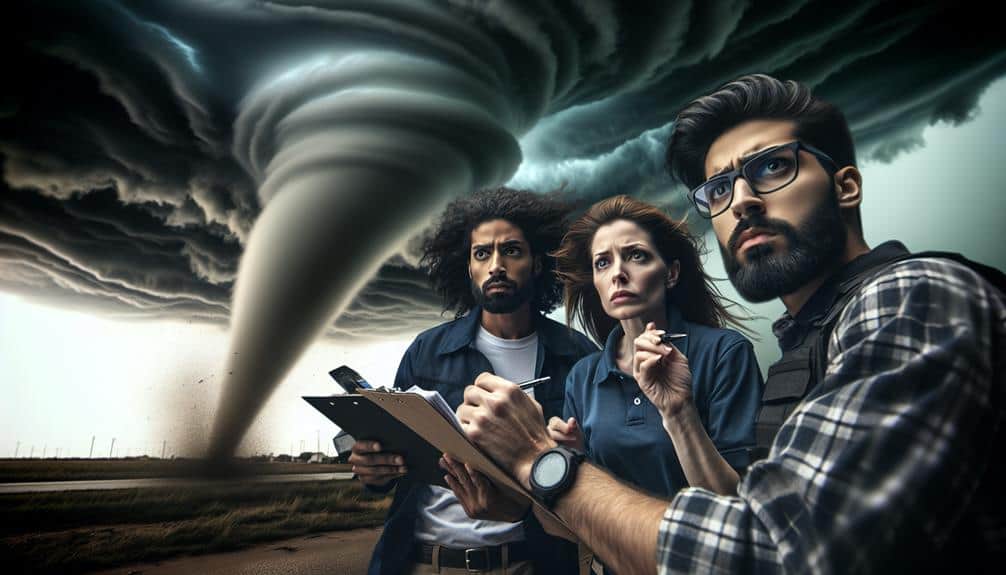We must minimize the impact of storm chasing on emergency services to keep the public safe. By following safety protocols, maintaining effective communication, and complying with legal guidelines, storm chasers can prevent strain on first responders. Coordination with local authorities and ethical conduct are essential; it guarantees smooth operation and resource allocation during severe weather events. Using technology for real-time interaction and engaging in regular training exercises with emergency services also improves overall response efficiency. Let's embrace these measures to safeguard emergency services while responsibly pursuing storm chasing.
Key Points
- Adhere to legal guidelines and permit requirements to avoid obstructing emergency services.
- Equip vehicles with safety measures and maintain situational awareness to prevent accidents.
- Use designated communication channels for real-time updates, ensuring clear and consistent information flow.
- Participate in regular training exercises with local emergency services to enhance coordination.
Recognizing Emergency Services' Role
Emergency services play a crucial role in securing public safety during severe weather events. When storms hit, our first responders are the backbone of community protection. They work tirelessly, often putting their own lives at risk, to safeguard us from imminent dangers.
Recognizing the significance of these services isn't just about appreciating them—it's about understanding their critical function and the challenges they face.
In times of severe weather, emergency services coordinate evacuations, provide medical aid, and manage resources to lessen damage. Their presence guarantees that our communities can withstand and recover from the impact of natural disasters.
Community acknowledgment of these services should extend beyond mere gratitude. We need to actively support and advocate for the resources and training they need to perform their duties effectively.
Prioritizing Safety During Storm Chasing
We must prioritize safety by adhering to strict emergency protocols and using reliable equipment during storm chasing.
Ensuring our vehicles are equipped with essential safety measures can prevent accidents and reduce strain on emergency services.
Let's focus on strategies that enhance our preparedness and minimize risks.
Emergency Protocols for Chasers
Storm chasers must follow strict protocols to guarantee their safety and minimize their impact on emergency services. By adhering to these guidelines, we can secure our storm tracking activities don't hinder emergency response teams.
Our primary goal is to collect data while staying out of harm's way and allowing emergency services to do their job unhindered.
To prioritize safety, we must:
- Maintain constant communication: Use radios or mobile networks to stay updated on weather changes and coordinate with other chasers.
- Follow local regulations: Respect road closures, evacuation orders, and any directives from emergency services.
These steps are essential for minimizing our footprint and securing that emergency responders can operate without additional obstacles.
Effective storm tracking requires us to be vigilant and responsible, as our actions directly impact community safety and emergency response efficiency.
Equipment and Safety Measures
Proper gear and strict safety measures are crucial for safeguarding our well-being during storm chasing activities. We must prioritize our safety by investing in high-quality safety equipment, including helmets, reinforced clothing, and first-aid kits. This equipment not only shields us from flying debris but also guarantees that we're ready for any unexpected injuries.
Equally vital is vehicle upkeep. Our vehicles are essential during storm chases, and their dependability can't be compromised. Regularly inspecting tire pressure, brakes, and fluid levels is non-negotiable. Additionally, installing specialized storm chasing tools like weather radar, GPS devices, and emergency communication systems ensures we can navigate hazardous conditions effectively.
Let's not overlook the significance of situational awareness. By staying informed about the storm's trajectory and potential dangers, we can make immediate decisions that prioritize our safety and reduce our reliance on emergency services.
In essence, our ability to chase storms responsibly hinges on equipping ourselves adequately and maintaining our vehicles diligently. This not only protects our lives but also allows emergency services to concentrate on those in urgent need.
Effective Communication Protocols

Clear and consistent communication protocols are essential to make sure storm chasers don't hinder emergency response efforts. By establishing guidelines and effective communication strategies, we can confirm that our actions support, rather than obstruct, emergency services. These protocols aren't just about relaying information but also about coordinating our efforts to enhance safety and efficiency.
To achieve this, we should focus on:
- Real-time updates: Regularly share our locations and storm observations with emergency services to help them make informed decisions.
- Designated communication channels: Use specific frequencies or platforms to avoid clogging emergency lines, making certain that critical information flows smoothly.
Legal Guidelines for Storm Chasers
Alongside effective communication, we must also adhere to legal guidelines that guarantee our storm chasing activities don't infringe upon the law or compromise public safety. Understanding and respecting permit requirements is essential. In certain regions, obtaining a permit may be necessary, especially when entering restricted areas or during severe weather events. By securing these permits, we demonstrate our commitment to lawful and responsible storm chasing.
Equally important are ethical guidelines. We've to make sure our presence doesn't hinder emergency services or put others at risk. For instance, we shouldn't block roads, impede rescue operations, or trespass on private property. These actions not only break the law but also endanger lives.
We must also stay informed about local regulations. Laws can vary widely between jurisdictions, so it's our responsibility to know and follow the rules wherever we chase storms. This diligence protects our freedom to continue our pursuits without legal repercussions.
Collaborative Efforts With Authorities

We must work closely with authorities to establish coordinated response strategies that enhance safety and efficiency during storms.
By setting up real-time communication channels, we can share crucial information promptly and reduce the risk of miscommunication.
These collaborative efforts will help guarantee that both storm chasers and emergency services operate seamlessly together.
Coordinated Response Strategies
Effective storm chasing requires seamless coordination with local emergency services to guarantee both public safety and the efficient allocation of resources. By working closely with authorities, we can reduce the strain on emergency services and secure a more organized response during severe weather events.
A coordinated strategy involves multiple layers of collaboration:
- Public awareness campaigns: Informing the public about storm chasing activities and potential hazards helps prevent unnecessary panic and secures that people know how to stay safe.
- Community engagement initiatives: Engaging local communities in preparedness efforts secures that residents are equipped with the knowledge and tools needed to respond effectively in emergencies.
Real-Time Communication Channels
Real-time communication channels are necessary for guaranteeing that storm chasers and local authorities can share important information instantly and make coordinated decisions during severe weather events. By establishing robust lines of communication, we can enhance our ability to track storms accurately and relay vital updates to emergency services. This improved communication helps us avoid duplicating efforts and guarantees that all parties are on the same page, leading to more efficient response coordination.
First, let's harness technology to create seamless communication networks. Mobile apps, dedicated radio frequencies, and online platforms can serve as essential tools for real-time interaction. By integrating GPS data and live video feeds, we can offer authorities a thorough view of storm developments, allowing them to allocate resources more effectively.
Next, we should set up regular training exercises with local emergency services. These drills will familiarize both storm chasers and authorities with the communication protocols and ensure everyone knows their role during an actual event. By collaborating closely, we can reduce the burden on emergency services, allowing them to focus on critical tasks like evacuation and medical aid.
Ethical Responsibilities in Storm Chasing
Storm chasers have a duty to guarantee their activities don't hinder emergency services during severe weather events. Our actions should reflect a strong sense of ethics and accountability, ensuring that we're not just thrill-seekers but responsible members of the community. Engaging with local residents and emergency services can help us better understand the impact of our presence and adjust our behavior accordingly.
We must adhere to professional conduct to maintain a positive public perception. Reckless behavior not only endangers lives but also tarnishes the reputation of all storm chasers. By acting responsibly, we can demonstrate that we respect the critical work of emergency services.
To visualize our commitment to ethical responsibilities, consider the following:
- Clear Communication: Establish reliable communication channels with local authorities to stay informed and avoid obstructing emergency operations.
- Safety Zones: Always maintain a safe distance from the storm to prevent clogging roads needed by emergency vehicles.
Frequently Asked Questions
How Can Storm Chasers Stay Informed About Changing Weather Conditions in Real-Time?
We can stay informed about changing weather conditions in real-time by using reliable weather apps and monitoring live streams. These tools give us the freedom to make quick decisions and maximize our storm chasing experience.
What Equipment Is Essential for Safe and Effective Storm Chasing?
When 80% of storm chasers cite safety gear and communication devices as essential, we understand they're important. We need weather radios, GPS systems, helmets, and first aid kits to stay safe and connected. Let's prioritize preparedness.
How Do Storm Chasers Document Their Findings Without Interfering With Emergency Services?
We document our findings responsibly by avoiding interference with emergency services. We use real-time data sharing and respect designated zones, ensuring our presence doesn't hinder rescue efforts, maintaining a balance between our research and public safety.
Are There Specific Training Programs for Aspiring Storm Chasers?
Aspiring storm chasers, you'll find the eye of the storm in dedicated training programs. These courses emphasize safety protocols and professional development, ensuring we're well-prepared and knowledgeable in the thrilling pursuit of understanding severe weather.
What Are the Best Practices for Storm Chasers to Follow During Severe Weather Events?
We must adhere to strict safety precautions, maintain clear communication protocols, and follow ethical guidelines. Collaborating with the community guarantees everyone's safety and enjoyment while chasing storms. Let's respect boundaries and prioritize safety above all.


